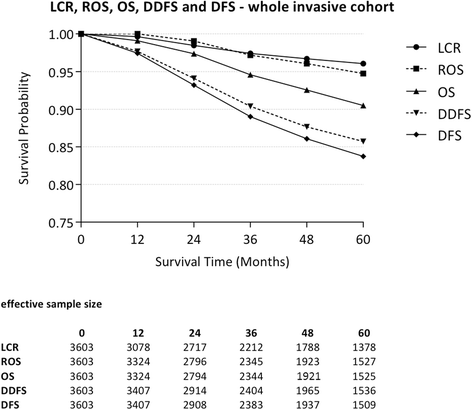Prognosis of breast cancer molecular subtypes in routine clinical care: A large prospective cohort study
- PMID: 27634735
- PMCID: PMC5024419
- DOI: 10.1186/s12885-016-2766-3
Prognosis of breast cancer molecular subtypes in routine clinical care: A large prospective cohort study
Abstract
Background: In Germany, most breast cancer patients are treated in specialized breast cancer units (BCU), which are certified, and routinely monitored. Herein, we evaluate up-to-date oncological outcome of breast cancer (BC) molecular subtypes in routine clinical care of a specialized BCU.
Methods: The study was a prospectively single-center cohort study of 4102 female cases with primary, unilateral, non-metastatic breast cancer treated between 01 January 2003 and 31 December 2012. The five routinely used molecular subtypes (Luminal A-like, Luminal B/HER2 negative-like, Luminal B/HER2 positive-like, HER2-type, Triple negative) were analyzed. The median follow-up time of the whole cohort was 55 months. We calculated estimates for local control rate (LCR), disease-free survival (DFS), distant disease-free survival (DDFS), overall survival (OS), and relative overall survival (ROS).
Results: Luminal A-like tumors were the most frequent (44.7 %) and showed the best outcome with LCR of 99.1 % (95 % CI 98.5; 99.7), OS of 95.1 % (95 % CI 93.7; 96.5), and ROS of 100.0 % (95 % CI 98.5; 101.5). Triple negative tumors (12.3 %) presented the poorest outcome with LCR of 89.6 % (95 % CI 85.8; 93.4), OS of 78.5 % (95 % CI 73.8; 83.3), and ROS of 80.1 % (95 % CI 73.8; 83.2).
Conclusions: Patients with a favorable subtype can expect an OS above 95 % and an LCR of almost 100 % over 5 years. On the other hand the outcome of patients with HER2 and Triple negative subtypes remains poor, thus necessitating more intensified research and care.
Keywords: Breast cancer; Breast care unit; Molecular subtypes; Outcome.
Figures


References
-
- Ellis MJ, Perou CM. The genomic landscape of breast cancer as a therapeutic roadmap. Can Discov. 2013;3(1):27–34. doi: 10.1158/2159-8290.CD-12-0462. - DOI - PMC - PubMed
MeSH terms
Substances
LinkOut - more resources
Full Text Sources
Other Literature Sources
Medical
Research Materials
Miscellaneous

